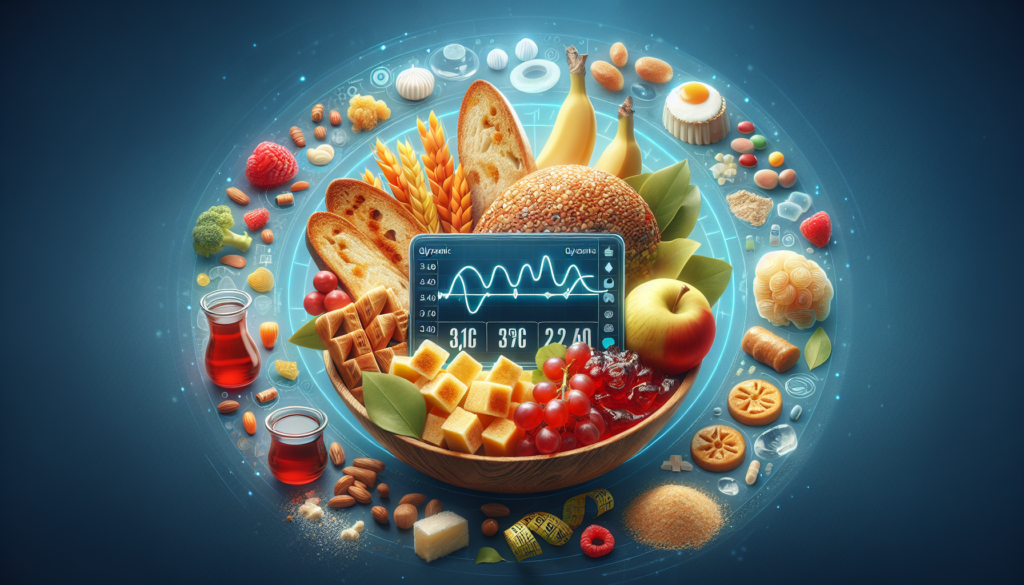Have you ever wondered why some carbohydrates affect your blood sugar levels more than others? Well, that’s where the glycemic load comes into play! In this captivating article, we will explore the concept of glycemic load and how it goes beyond the traditional glycemic index. With a friendly tone, we will guide you through the key differences and explain why understanding the glycemic load is crucial for managing your blood sugar levels and making healthier food choices. So, let’s embark on this enlightening journey to unravel the mysteries of the glycemic load together!

What is the Glycemic Index?
The Glycemic Index (GI) is a measurement system that ranks foods based on the rate at which they raise blood sugar levels. It provides a relative value to different carbohydrates, indicating how quickly they are broken down and absorbed into the bloodstream. This index is particularly beneficial for individuals who need to manage their blood sugar levels, such as those with diabetes or those trying to maintain a healthy weight.
Definition of the Glycemic Index
The Glycemic Index is a scale that ranges from 0 to 100, with 100 representing pure glucose. Foods are categorized as either low GI (55 or less), medium GI (56-69), or high GI (70 or more) based on how quickly they cause blood sugar levels to rise.
How it is measured
To determine a food’s GI, it is tested on a group of individuals who consume a portion of the food after an overnight fast. Blood samples are taken at regular intervals to measure blood sugar levels over a period of two hours. The results are then compared to the blood sugar response of individuals consuming a standard reference food, typically glucose.
Impact of high and low GI foods
Foods with a high GI cause a rapid increase in blood sugar levels after consumption, leading to a quick burst of energy followed by a subsequent crash. These foods include white bread, refined grains, sugary drinks, and processed snacks. On the other hand, foods with a low GI cause a slower, more sustained release of glucose into the bloodstream, providing a steady source of energy. Examples of low GI foods are whole grains, legumes, fruits, and vegetables.
Limitations of the Glycemic Index
While the Glycemic Index is a valuable tool, it does have some limitations that should be considered.
Inaccuracy of the GI values
The GI values assigned to foods are based on averages, and individual foods can vary in their GI depending on factors such as ripeness, processing, and cooking methods. This means that the GI value of a specific food may not always accurately reflect its impact on an individual’s blood sugar levels.
Individual variations in GI response
Each person’s response to carbohydrates can differ based on factors such as genetics, gut microbiome, and overall health. This means that two individuals consuming the same food may experience different effects on their blood sugar levels.
Introducing the Glycemic Load
To overcome some of the limitations of the Glycemic Index, another measurement called Glycemic Load (GL) was developed. Glycemic Load takes into account both the quality and quantity of carbohydrates consumed.
Definition of the Glycemic Load
The Glycemic Load represents the overall impact of a food on blood sugar levels by considering both the GI value and the amount of carbohydrates in a typical serving of that food.
How it differs from the Glycemic Index
While the Glycemic Index focuses solely on the rate at which a food raises blood sugar levels, the Glycemic Load provides a more comprehensive picture by considering both the GI and the amount of carbohydrates consumed. This allows individuals to better understand the overall impact of a food on blood sugar levels.
Calculating the Glycemic Load
Calculating the Glycemic Load of a food involves a simple formula that takes into account both the GI value and the total carbohydrates in a serving.
Formula for calculating Glycemic Load
The Glycemic Load of a food is calculated by multiplying the food’s GI value by the total grams of carbohydrates in a serving, and then dividing by 100.
Glycemic Load = (GI x Total Carbohydrates in a Serving) / 100
Factors affecting the Glycemic Load
The Glycemic Load of a food can also be influenced by factors such as cooking methods, food combinations, and processing. For example, cooking rice for a longer period of time can increase its Glycemic Load, while combining a low-GI food with a high-GI food can help balance out the overall Glycemic Load of a meal.

Advantages of considering Glycemic Load
Considering the Glycemic Load of foods offers several advantages over solely focusing on the Glycemic Index.
Holistic view of carbohydrate impact
By taking into account both the quality and quantity of carbohydrates, Glycemic Load provides a more comprehensive view of how different foods affect blood sugar levels. This allows individuals to make more informed choices about their carbohydrate intake, taking into consideration factors such as portion sizes and food combinations.
Better glycemic control
Managing blood sugar levels is crucial for individuals with diabetes or those at risk of developing the condition. By considering the Glycemic Load, individuals can more effectively regulate their blood sugar, reduce insulin spikes, and improve glycemic control.
Weight management benefits
High Glycemic Load foods can contribute to weight gain and obesity due to their impact on blood sugar levels and subsequent insulin response. By incorporating more low Glycemic Load foods into the diet, individuals can better manage their weight and promote a healthier body composition.
Impact of Glycemic Load on Blood Sugar
Understanding the impact of the Glycemic Load on blood sugar levels is essential for managing diabetes and maintaining overall health.
How Glycemic Load affects blood sugar levels
Foods with a higher Glycemic Load cause blood sugar levels to rise more rapidly and to a greater extent than foods with a lower Glycemic Load. This can result in sharper spikes in blood sugar levels, leading to increased insulin secretion and potential long-term health complications.
Importance for managing diabetes
For individuals with diabetes, monitoring and controlling blood sugar levels is critical. By focusing on low Glycemic Load foods and managing portion sizes, individuals can more effectively regulate their blood sugar levels, reducing the risk of complications associated with diabetes.
Glycemic Load and Health Conditions
The Glycemic Load has been extensively studied and has shown potential benefits in relation to various health conditions.
Relation to cardiovascular disease
Research suggests that a high Glycemic Load diet may be associated with an increased risk of cardiovascular disease. High Glycemic Load foods can lead to elevated blood sugar levels, which may contribute to inflammation, insulin resistance, and a higher likelihood of developing heart disease.
Role in prevention of chronic diseases
Certain chronic diseases, such as metabolic syndrome and type 2 diabetes, are closely linked to high blood sugar levels and insulin resistance. By adopting a diet that focuses on low Glycemic Load foods, individuals may reduce their risk of developing these chronic diseases and maintain better overall health.
Determining Glycemic Load of Foods
Determining the Glycemic Load of a specific food can be done using available resources and understanding the GI and carbohydrate content.
Measuring Glycemic Load of different foods
Multiple resources are available that provide Glycemic Load values for a wide range of foods. These resources often include tables or databases that allow individuals to search for specific foods and their corresponding Glycemic Load values.
Food categories with varying Glycemic Load
Food categories can vary significantly in their Glycemic Load. For example, fruits and vegetables generally have a lower Glycemic Load compared to processed carbohydrates or sugary desserts. By focusing on these lower Glycemic Load food categories, individuals can make healthier choices that promote better blood sugar control.
Influence of Food Preparation on Glycemic Load
The way in which food is prepared can impact its Glycemic Load, so it’s important to consider cooking methods when aiming for a lower overall Glycemic Load.
Effects of cooking methods on Glycemic Load
Certain cooking methods, such as boiling or steaming, tend to result in a lower Glycemic Load compared to frying or baking. Cooking methods that slow down the release of glucose from carbohydrates can help reduce the overall impact on blood sugar levels.
Choosing low Glycemic Load cooking techniques
To reduce the Glycemic Load of a meal, individuals can opt for cooking techniques that promote slower glucose release. This can be achieved through methods such as blanching, sautéing, or using a slow cooker. Additionally, incorporating more raw foods into the diet, such as salads or lightly cooked vegetables, can also help lower the overall Glycemic Load.
Balancing Glycemic Load in a Diet
Incorporating low Glycemic Load foods and utilizing food combinations can help balance the overall Glycemic Load of a diet.
Incorporating low Glycemic Load foods
Including more low Glycemic Load foods in the diet, such as whole grains, legumes, nuts, seeds, and non-starchy vegetables, can help reduce the overall impact on blood sugar levels. These foods provide a steady release of glucose, promote satiety, and offer a range of essential nutrients.
Combining foods for optimal Glycemic Load
Combining different foods can also help optimize the Glycemic Load of a meal. Pairing high GI foods with low GI foods can help balance out the overall Glycemic Load. For example, adding protein, healthy fats, or fiber-rich foods to a high GI food can help slow down the absorption of glucose and decrease the impact on blood sugar levels.
By understanding the Glycemic Load and incorporating low Glycemic Load foods into your diet, you can better manage your blood sugar levels, promote overall health, and make informed choices about the carbohydrates you consume. Remember to always consult with a healthcare professional or nutritionist for personalized advice based on your specific health needs.

